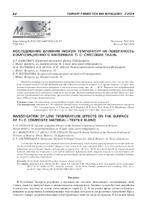| dc.contributor.author | Анисович, А. Г. | ru |
| dc.contributor.author | Маркевич, М. И. | ru |
| dc.contributor.author | Акула, И. П. | ru |
| dc.contributor.author | Чекан, Н. М. | ru |
| dc.contributor.author | Щербакова, Е. Н. | ru |
| dc.coverage.spatial | Минск | ru |
| dc.date.accessioned | 2024-06-13T09:48:44Z | |
| dc.date.available | 2024-06-13T09:48:44Z | |
| dc.date.issued | 2024 | |
| dc.identifier.citation | Исследование влияния низких температур на поверхность композиционного материала Ti-C – смесовая ткань = Investigation of low temperature effects on the surface of Ti-C composite material – textile blend / А. Г. Анисович [и др.] // Литье и металлургия. – 2024. – № 2. – С. 82-87. | ru |
| dc.identifier.uri | https://rep.bntu.by/handle/data/145145 | |
| dc.description.abstract | Продемонстрирован метод формирования композиционного материала, заключающегося в том, что на одну сторону смесовой ткани 07С11-КВ (производство ОАО «Моготекс») наносили титан, а на другую сторону – углерод. Проведены испытания полученного материала в климатической камере при –20 … –40 °С. Показано, что разработанный композиционный материал хорошо выдерживает пониженные температуры, не наблюдается дополнительной деформации композиционного материала и дефектов структуры. Данный композиционный материал может быть рассмотрен как перспективный для специальных применений в условиях пониженных температур (антистатических, поглощающих СВЧ излучение, биомедицинских). | ru |
| dc.language.iso | ru | ru |
| dc.publisher | БНТУ | ru |
| dc.title | Исследование влияния низких температур на поверхность композиционного материала Ti-C – смесовая ткань | ru |
| dc.title.alternative | Investigation of low temperature effects on the surface of Ti-C composite material – textile blend | ru |
| dc.type | Article | ru |
| dc.identifier.doi | 10.21122/1683-6065-2024-2-82-87 | |
| local.description.annotation | A method for the formation of a composite material is demonstrated, which involves applying titanium to one side of the textile blend 07S11-KV (produced by OJSC “Mogotex”) and carbon to the other side of the fabric. Tests were conducted on the obtained material in a climatic chamber at temperatures ranging from –20 °C to –40 °C. It is shown that the developed composite material withstands low temperatures well, with no additional deformation of the composite material or structural defects observed. This composite material can be considered as promising for special applications in low-temperature conditions (antistatic, microwave absorbing, biomedical). | ru |

